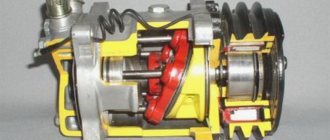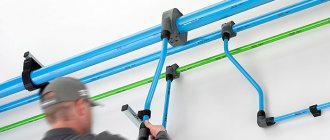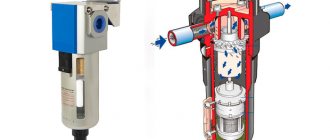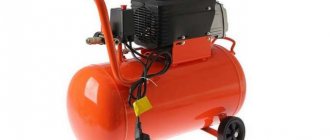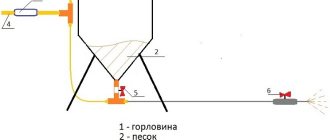In order to clean a contaminated surface, remove dust, soot or rust, paint or varnish residues from it, different cleaning methods are used. Cleaning is done using a damp or dry rag, sponge or sandpaper, wire brush or file. But processing with these products often leaves scratches on the surface being cleaned. To prevent this from happening, other, more gentle processing methods are used, one of which is sandblasting.
In addition, this natural material perfectly polishes the surface. This method is used to clean walls from plaster, paint, to make walls rough, and when carrying out other finishing work.
Sandblasting, as the name suggests, is the cleaning of an exposed surface using sand. At the same time, such a natural abrasive substance not only cleans the surface, but at the same time also polishes it . With this method, sand is supplied at high speed to the object being cleaned under the influence of compressed air.
Application of technology
Sand treatment is used for the following purposes.
- Treatment of metal products to remove rust or paint residues before applying anti-corrosion coatings and other protective agents to the surface of structural elements.
- Grinding the surface of wooden, stone, plastic, ceramic or metal blanks, parts or finished products for subsequent application of a decorative coating.
- Applying inscriptions and drawings on household items or furniture.
- Frosting of glass. It is used when processing mirrors to give them an opaque effect, for applying patterns to glass (artistic matting). This method is also used for decorating glass surfaces of dishes, processing window glass, shower panels. Used in production.
- Restoration of decorative art objects or other products.
- Degreasing metal parts before their subsequent coating with varnish or paint.
- Processing walls to give them the effect of surface roughness.
- Giving wooden products an aging effect. It is used when processing furniture, interior items, and decorative elements: caskets, figurines, boxes, drawers.
- Grinding of car parts and surface cleaning of the body from dirt and corrosion for subsequent processing.
Industry sectors
Sandblasting is used in various industrial sectors and areas:
- construction - to create a textured wall surface. Sandblasting equipment is used to clean brickwork and treat wooden surfaces;
- instrument making - for processing workpieces and cleaning them;
- reinforcement;
- automobile;
- metallurgical and other industries.
To carry out this treatment, various means are used, one of which is a sandblasting gun.
How to choose the right model?
Before buying sandblasting machines, you need to familiarize yourself with a number of factors that affect the performance of the equipment:
- Sandblasting devices must be equipped with thick-walled hoses to withstand prolonged exposure to abrasive and pressure.
- The abrasive feed rate depends on the size of the hole on the nozzle.
- It is not recommended to buy models with plastic parts, as they will quickly fail.
- You need to evaluate the pen before purchasing so that it is convenient to work in the future.
If you need a model for your home, garage, or workshop, you need to buy a unit with a container for abrasive.
Operating principle
Such equipment varies depending on its shape and design, power, functions performed and method of operation.
The principle of operation of sandblasting guns of any model is simple: the surface being treated is cleaned under the influence of a powerful, narrowly directed jet of sand, which is directed onto the surface to be cleaned under the influence of compressed air pressure of several atmospheres. As a result of such actions, the excess layer is removed from the surface .
Quartz sand processed in a special way is used as an abrasive material for guns.
Sandblasting guns are used for car repair work, used in the glass and construction industries, and used in almost all industries.
Construction of sandblasting guns
A standard pistol consists of parts:
- sand container;
- compressor;
- nozzle holder;
- nozzle;
- sand supply regulator;
- abrasion resistant sleeve.
The nozzle holder, nozzle and sleeve make up the body of the gun, with the help of which the abrasive substance is sprayed.
The design features of a particular pistol model may vary. Some models have a remote control , with which it is convenient to carry out work on cleaning the surface while being at some distance from it. Such devices are more expensive than manually controlled models.
The capacity of the sand tank ranges from 25 to 300 or more liters. The higher this number, the more abrasive substance will fit in the tank, the longer the device can be used. Devices with a larger tank volume have more power and are more expensive.
The sand contained in the container enters the gun through a hose. A jet of compressed air is generated using a sandblasting compressor. Thanks to it, the abrasive powder escapes from the barrel of the gun. The speed increases as the substance passes through the abrasion-resistant sleeve. Thus, the abrasive powder particles receive a speed sufficient to process the surface by repeatedly hitting the material on the coating.
Compressors for work
Modern compressors for technological equipment are manufactured in piston or screw versions. When screw compressors operate, the gas compression process occurs due to the rotation of two screws.
Screw compressor design:
Screw compressor structure: 1 – housing; 2 – rotor screw; 3 – roller type bearing; 4 – ball bearing; 5 – bearing support; 6 – sealing gland; 7 – end cover; 8 – a pair of gears of the gearbox.
Working process of a piston compressor: 1 – suction valve; 2 – discharge valve
The process of operation of a compressor is most easily understood by considering the diagram of a piston device. Available:
- cylinder;
- piston;
- crankshaft;
- intake and discharge valves located in the cylinder head.
- When the crankshaft rotates, the piston makes reciprocating movements. In this diagram they move up and down.
- When the piston moves downwards, a vacuum is created inside the cylinder. As a result, the suction valve opens. Air from the environment enters the cylinder.
- When the bottom dead center is reached, the volume expansion process stops. The piston begins to move upward.
- The pressure inside increases. As a result, the intake valve closes.
- When the pressure increases above a certain value, the discharge valve opens. Pressurized air is forced into the exhaust pipe.
- When the pushing cycle is complete, the valves close. In the future, all work is repeated.
Structurally, industrial installations have not one, but several cylinders. Therefore, during their operation, work occurs in a smooth mode. The flywheel balances vibration.
Multi-cylinder piston compressor design:
When a screw compressor operates, air is sucked in from the environment. The profiles of the screw pair are made in such a way that when gas is pushed into the spaces between the screws, the volume constantly decreases. There is a gradual compression of the working fluid.
The cycle is completed without sudden back-and-forth movements. Wear in this design is minimal. Therefore, most users consider using screw compressor machines. Their higher reliability has been proven over time. Therefore, if you have the opportunity to choose one type or another, then it is better to opt for screw systems.
Attention! Gas compression occurs in a short period of time. Heat exchange with the environment is limited
Therefore, in calculations it is assumed that the processes of compression and pushing of air occur adiabatically (without exchanging heat with the environment). Therefore, compressed air heats up by 300...450 ⁰С.
For normal operation of compressor units, cooling is necessary. Industrial devices have a water cooling jacket. Smaller units are cooled by a fan that blows air over the finned surface of the cylinder and cylinder head.
Types of sandblasting
Such devices can be divided into several types according to their functional features.
- Tank . In their design they are similar to ordinary spray guns. The tank of such devices is filled not with paint, but with fine-grained sand. Guns of this design are quite heavy due to the weight of the sand container. Similar models of sandblasting guns are used in auto repair shops to clean bodywork and other surfaces of cars.
- Hose . They have two hoses in their design. One of them is used to supply compressed air, and the second to supply an abrasive substance. Such devices are suitable for work in construction, as well as for frosting glass using the industrial method.
- Chamber . Such guns are designed for all kinds of processing of small surfaces of glass, ceramic or metal products placed in a special insulated sandblasting container - chamber. Its dimensions are determined by the shape and parameters of such devices.
- Tubeless . The remaining sandblasting guns are open-type devices that do not have a chamber.
Tips for choosing
For the most optimal option, you should pay attention to:
- Device type. With a tank, the model is suitable for frequent work, but not for decent surfaces. But if you have to work at a distance, and space allows, equipment with a hose will do. There is also a third option - a sandblasting gun with recirculation. The choice is individual.
- Certificate and test passport. Any worthwhile product should have them.
- Weight. The design should not be particularly heavy, so that your hands do not get tired and the duration of the work process increases in time.
- Material consumption. The most optimal in this regard is considered to be a sandblasting gun with an abrasive recycling system, although the task of preferences is solved individually.
- Field of activity. Choose sandblasting based on your needs and capabilities.
- Types and availability of nozzles, as well as material of manufacture. One of the best and most durable materials will be alloys with cobalt and tungsten carbide.
- Attaching the nozzle to the body: the union nut can spontaneously unscrew during long-term operation; in this regard, the threaded pin is more reliable.
- Ergonomics. The handle should fit comfortably in the hand, and all other components should not cause discomfort during operation.
- Mounting holes. They make it possible to significantly facilitate the process of processing the desired surface.
- The characteristics of the proposed sandblasting tool must match the capabilities of the compressor (the compressor must have a pressure reserve of 15-20%).
- Price. It depends on your capabilities, requirements and wallet size. Products that are too cheap are not even worth looking at, as they are usually made from low-quality materials and will not last long.
- Other parameters. Before purchasing, it is best to consult with knowledgeable people and specialists and look at reviews of the product you like. They will tell you exactly what to consider when choosing a device for your home, production or workshop.
- Brand. Choose only a manufacturer that has been proven over the years and under no circumstances recommend purchasing a previously used device.
Source
Homemade pistols
Such devices are made at home. According to their design features, they are classified as tank-type sandblasting guns; they use an ordinary plastic bottle as a tank for storing abrasive powder.
The most important parts of a sandblaster are the spray tip and the nozzle. They must be made of the most durable material , as they are exposed to the strongest impact of abrasive powder and compressed air pressure.
Ceramic and cast iron parts quickly fail under such influence and can only be used for a short time, since such materials are not wear-resistant. In order for the gun to be used for as long as possible, it is better to give preference to models with a nozzle made of tungsten, or choose boron parts.
The tips are also not very durable structural elements and also often wear out even with sandblasting devices made in an industrial way. Therefore, the best solution would be to purchase tips in specialized departments of stores or in construction markets.
The sandblasting body itself must be made to fit the size of the nozzle. Then a handle is attached to it, to which two fittings are attached. One of them is located at the top. It will be needed for a plastic bottle with sand. The second fitting must be connected to a compressor, which also needs to be purchased. A plumbing tee is often used as the body of a homemade sandblasting gun.
The compressor for the gun must be equipped with a receiver that will provide a uniform supply of air stream under stable pressure. The power of the compressor depends on what surface is planned to be processed. Concrete and metal surfaces will require more compressor power, and wooden surfaces will require less.
You cannot use ordinary river sand as a material for a gun . Even if it is thoroughly washed and sifted, it will not be possible to achieve the desired quality of abrasive at home, since a homemade sandblasting machine will quickly become unusable. In addition, the surface processed with it will also not be of good quality. Therefore, to avoid premature failure of the device and to comply with the processing technology, it is best to buy the required abrasive material in a specialized store. The cost of such sand will not require large financial outlays.
It doesn’t matter which sandblasting gun you choose - homemade or manufactured. The main thing is that it copes with its functions perfectly, allowing you to achieve the best results.
What can sandblasting be made from?
To understand how easy it is to make sandblasting with your own hands, it is enough to dwell on the operating features of each structural unit. In this case, the selection of available parts or finished products becomes obvious.
- Mixing unit. Sand for sandblasting and compressed air from the compressor come here from two hoses. The output is a ready-made air-abrasive mixture. In this case, no requirements, for example, the volume of the mixing chamber, are imposed on the unit. On this basis, you can use a regular plumbing tee to make it.
- Control devices. A normal manual sandblaster should be able to adjust the air flow and the intensity of the abrasive material. In this case, no requirements are imposed on the control device. At home, this role is well performed by water ball valves made of steel.
- Connection points. To connect the hoses, conventional fittings are installed on the portable sandblasting machine. They can be equipped with clamps for secure fastening. All these components are easy to buy in stores.
- Receiver. This part of the design is needed to facilitate the operation of the compressor and stabilize the pressure. You will definitely need a receiver if you want to get a powerful sandblast with your own hands. This device can be made from a powder type fire extinguisher with a large housing capacity. Another option is to make a receiver from a gas cylinder.
- Abrasive chamber. The components for its manufacture may differ depending on the type of installation being created. For example, an ejector-type mini sandblasting machine is assembled with a plastic bottle for abrasive. A pressure installation will require a durable container made from a fire extinguisher or a freon cylinder.
Advantages and disadvantages
The main advantages of sandblasting machines of this type include the following.
- Variety of price ranges for pistols. You can purchase simple budget economy class models, or you can choose expensive guns used for decorating glass surfaces and matting mirrors.
- Small tool sizes. Sandblasters come in different sizes and shapes. You can choose designs whose small size allows you to carry out surface cleaning work in hard-to-reach places and confined spaces.
- Simplicity of design. You can assemble these pistols yourself at home.
- Easy to use. Sandblasting is easy to operate. It comes into motion thanks to the control panel or when you press the trigger.
- Sandblasting models can be assembled yourself.
- Savings on the cost of cleaning and surface preparation for finishing carried out using traditional methods.
- Saving time and labor costs. Removing peeling plaster or floor varnish from walls is much faster when using a sandblasting gun than doing manual cleaning work.
There are not many disadvantages to using sandblasting equipment. It can be noted that all pistols have the following disadvantages .
- They have a fairly short service life. At the same time, it will be lowest for budget devices, compared to the service life of more expensive models.
- The devices are distinguished by a fairly high level of noise produced during operation. When performing surface treatment with sandblasting, be sure to use a protective suit, helmet and goggles so as not to cause harm to health.
- The formation of a huge amount of dust, the clouds of which can cause significant harm to the health of nearby people. In addition, dust settles on surfaces and objects located close to where the gun is used.
- By taking all necessary precautions, you can reduce the level of adverse health effects. By removing or covering objects with a special film, you can protect them from exposure to dust and reduce the time spent on subsequent cleaning after sandblasting.
Selection of main compressor characteristics
In many reference materials you can find data that the minimum compressor performance threshold should be 500 liters per minute at a pressure of 5 bar. However, almost nowhere is the truth told. You can choose a compressor for sandblasting with such characteristics even without the necessary piping. However, at the same time:
- the sandblasting machine will only be able to work with limited types of surfaces and coatings;
- Long-term use of the sandblasting unit is not ensured - pauses are required to cool the engine;
- a sandblasting compressor will display all its design features, in particular, rotary models will inevitably supply air in jerks.
Based on practical experience and recommendations from leading manufacturers of professional equipment, an honest assessment of the minimum requirements for an injection system can be made. The compressor must necessarily work with a receiver piping. With the correct choice of its volume, it is possible to achieve the required continuity of operation, even if a piston-type supercharger is used.
The basic requirements for choosing a compressor for a sandblasting machine depend on the materials and nature of the coatings with which you will have to work:
- for processing concrete, chamber surfaces, wall brickwork, the minimum operating pressure should be 3 bar;
- when working with metal, the compressor must provide a pressure of 6 bar;
- To remove tough coatings, the recommended pressure is 9 bar.
The maximum you should aim for if you want to choose a compressor for sandblasting with high versatility is a pressure of 12 bar. In the recommendations under consideration, it is assumed that the diameter of the working nozzle is 5 mm, and the pumping level is 800 l per minute.
Advice! Today, many manufacturers offer ready-made air stations for sandblasting machines, providing performance levels from 700 to 1000 liters per minute with pressures up to 12 bar. It is this kit that is recommended to be purchased to achieve optimal performance and ease of use in a workshop environment. For industrial purposes, it is recommended to choose a device with a capacity of 3000-5000 l/minute and an outlet pressure of up to 10 bar. Typically these are screw type compressors.



